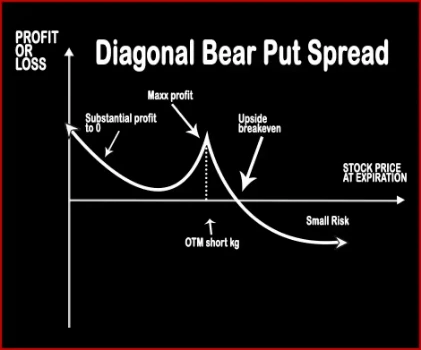Compare Strategies
| SHORT STRADDLE | DIAGONAL BEAR PUT SPREAD | |
|---|---|---|

|

|
|
| About Strategy |
Short Straddle Option strategyThis strategy is just the opposite of Long Straddle. A trader should adopt this strategy when he expects less volatility in the near future. Here, a trader will sell one Call Option & one Put Option of the same strike price, same expiry date and of the same underlying asset. If the stock/index hovers around the same levels then both the options will expire worthless an |
Diagonal Bear Put SpreadWhen the trader is neutral – bearish in the near-month and bearish in the mid-month, he will apply Diagonal Bear Put Spread. This strategy involves buying Mid-Month ITM Put Options and selling (short/write) equal number of Near-Month OTM Put Options, of the same underlying asset. This strategy bags limited rewards with limited risk. |
SHORT STRADDLE Vs DIAGONAL BEAR PUT SPREAD - Details
| SHORT STRADDLE | DIAGONAL BEAR PUT SPREAD | |
|---|---|---|
| Market View | Neutral | Bearish |
| Type (CE/PE) | CE (Call Option) + PE (Put Option) | PE (Put Option) |
| Number Of Positions | 2 | 2 |
| Strategy Level | Advance | Beginners |
| Reward Profile | Limited | Limited |
| Risk Profile | Unlimited | Limited |
| Breakeven Point | Lower Breakeven = Strike Price of Put - Net Premium, Upper breakeven = Strike Price of Call+ Net Premium | This is a dynamic trade with many possible scenarios and future trades, it is impossible to calculate a breakeven. |
SHORT STRADDLE Vs DIAGONAL BEAR PUT SPREAD - When & How to use ?
| SHORT STRADDLE | DIAGONAL BEAR PUT SPREAD | |
|---|---|---|
| Market View | Neutral | Bearish |
| When to use? | This strategy is work well when an investor expect a flat market in the coming days with very less movement in the prices of underlying asset. | When the trader is neutral – bearish in the near-month and bearish in the mid-month, he will apply Diagonal Bear Put Spread. This strategy involves buying Mid-Month ITM Put Options and selling (short/write) equal number of Near-Month OTM Put Options, of the same underlying asset |
| Action | Sell Call Option, Sell Put Option | Sell 1 Near-Month OTM Put Option, Buy 1 Mid-Month ITM Put Option |
| Breakeven Point | Lower Breakeven = Strike Price of Put - Net Premium, Upper breakeven = Strike Price of Call+ Net Premium | This is a dynamic trade with many possible scenarios and future trades, it is impossible to calculate a breakeven. |
SHORT STRADDLE Vs DIAGONAL BEAR PUT SPREAD - Risk & Reward
| SHORT STRADDLE | DIAGONAL BEAR PUT SPREAD | |
|---|---|---|
| Maximum Profit Scenario | Max Profit = Net Premium Received - Commissions Paid | 'Premiums received - Initial premium to execute + Strike price - Stock Price on final month |
| Maximum Loss Scenario | Maximum Loss = Long Call Strike Price - Short Call Strike Price - Net Premium Received | When the stock trades up above the long-term put strike price. |
| Risk | Unlimited | Limited |
| Reward | Limited | Limited |
SHORT STRADDLE Vs DIAGONAL BEAR PUT SPREAD - Strategy Pros & Cons
| SHORT STRADDLE | DIAGONAL BEAR PUT SPREAD | |
|---|---|---|
| Similar Strategies | Short Strangle | Bear Put Spread and Bear Call Spread |
| Disadvantage | • Unlimited risk. • If the price of the underlying asset moves in either direction then huge losses can occur. | Higher commissions due to additional trades. , Changes maximum profit potential of call or put spreads. |
| Advantages | • A trader can earn profit even when there is no volatility in the market . • Allows you to benefit from double time decay. • Trader can collect premium from puts and calls option . | The Risk is limited. |